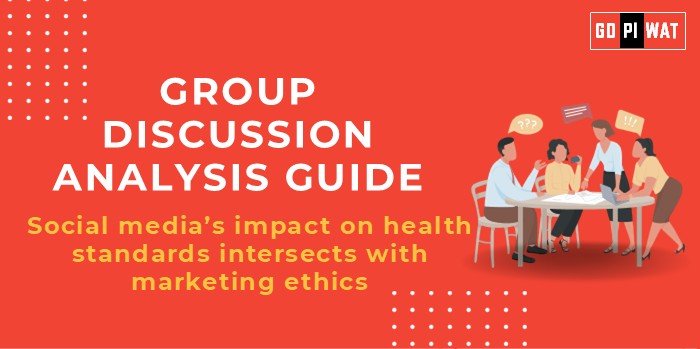📋 Group Discussion (GD) Analysis Guide
🌐 Introduction to “The Role of Social Media in Promoting Unrealistic Health Standards”
Social media platforms like Instagram and TikTok, with over 4.8 billion users worldwide, have revolutionized access to health and fitness content. However, they often perpetuate unattainable beauty and health ideals, influencing perceptions and behaviors.
Topic Background: The rise of influencers and image-driven content has been pivotal in shaping body image concerns. Studies link prolonged exposure to idealized content with mental health issues, such as anxiety, depression, and eating disorders.
📊 Quick Facts and Key Statistics
- 🌍 Global Social Media Users: 4.8 billion (2024) – Reflects the massive reach of social media platforms.
- 😟 Body Image Issues: 74% of young adults report dissatisfaction with their body due to online comparisons (APA, 2023).
- 🏋️♀️ Fitness Content Growth: A 65% increase in fitness-related hashtags on Instagram from 2020 to 2023.
- 🧠 Mental Health Impact: 1 in 5 adolescents diagnosed with eating disorders cites social media as a contributing factor (WHO, 2023).
🧑🤝🧑 Stakeholders and Their Roles
- Social Media Companies: Content algorithms often prioritize “idealized” body images for engagement.
- Influencers: Shape health standards through posts but may unintentionally promote unrealistic goals.
- Healthcare Professionals: Address rising health issues like eating disorders and body dysmorphia.
- Governments and NGOs: Implement regulations and campaigns promoting body positivity and mental health awareness.
- Users: Contribute by curating content and fostering discussions around inclusivity.
📈 Achievements and Challenges
🏆 Achievements
- 🎗️ Awareness Campaigns: Initiatives like #BodyPositivity and Dove’s Real Beauty campaign.
- 📚 Accessibility: Social media provides free health tips, fitness routines, and mental health resources.
- 🤝 Community Building: Support groups and discussions around overcoming body image issues.
⚠️ Challenges
- ❌ Misinformation: Pseudoscience and unsafe health tips.
- 😟 Mental Health Decline: Correlation between idealized content and eating disorders.
- 📈 Algorithm Bias: Promotes unrealistic standards to drive engagement.
🌍 Global Comparisons
- ✅ Positive Example: Norway mandates disclaimers for retouched photos in advertisements.
- ❌ Challenges Elsewhere: In the US, teens report high levels of social media-induced anxiety.
🗣️ Structured Arguments for Discussion
- Supporting Stance: “Social media amplifies fitness awareness, helping users adopt healthier lifestyles.”
- Opposing Stance: “The prevalence of unrealistic standards is leading to mental health crises, particularly in youth.”
- Balanced Perspective: “While social media fosters health awareness, its harmful impacts require regulatory intervention.”
🗨️ Effective Discussion Approaches
- 📊 Opening Approaches:
- “Statistics reveal 74% of young adults feel pressured by idealized online content.”
- “Let’s examine how #BodyPositivity campaigns are combating unrealistic standards.”
- 🤝 Counter-Argument Handling:
- “While social media promotes fitness awareness, its impact on vulnerable individuals cannot be overlooked.”
📉 Strategic Analysis of Strengths and Weaknesses
- ✔️ Strengths: Accessibility to health content, community support, growing awareness campaigns.
- ❌ Weaknesses: Promotes stereotypes, spreads misinformation, and lacks regulation.
- 💡 Opportunities: Leverage AI to filter harmful content, increase transparency, and promote inclusivity.
- ⚠️ Threats: Persistent mental health crises and unchecked influencer impact.
🎓 Connecting with B-School Applications
- 📈 Real-World Applications: Exploring the intersection of social media marketing and public health.
- 🎤 Sample Interview Questions:
- “How can businesses balance profit with responsible social media practices?”
- “Discuss a regulatory approach to curbing misinformation on health.”
- 💡 Insights for Students:
- Explore case studies in marketing ethics.
- Assess the role of technology in mental health interventions.


